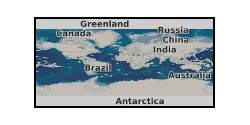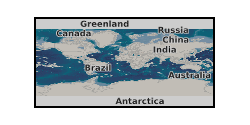EGDI
Type of resources
Available actions
Topics
Keywords
Contact for the resource
Provided by
Years
Formats
Representation types
Update frequencies
Service types
Scale
-

The Geo-Assessment Matrix (the Matrix) is a pan-European dataset highlighting the key geological features and associated engineering constraints for Offshore Wind Farm (OWF) development. Such geological features include: lithology; biogenic processes; mass flow processes; fluid flow; morphology and geomorphology associated with glacial, coastal, fluvial and marine settings. There is currently no universally adopted methodology or classification system to assess ground conditions at OWF sites. This lack of standardisation makes it difficult to compare siting conditions across different regions in Europe. The Geo-Assessment Matrix introduces a unified methodology designed to address these challenges. Results provide data attributions that can be used to create pan-European geological maps to better understand the geological constraints of the subsurface for offshore development. The Matrix is useful for stakeholders such as research institutes (Geological Surveys), marine spatial planners, government agencies and OWF developers. A matrix style is adopted providing a structured comparison of geological and engineering constraints for the development of different OWF foundation types (piles, suction caisson, gravity based structures – GBS, and cables). A final qualitative unmitigated geological constraint score is provided for evaluating the suitability of different seabed conditions: ‘Higher’, ‘Moderate’ and ‘Lower’ constraints. As this is a qualitative assessment, they are comparative terms, permitting categories that reflect the relative difference. - Higher constraint: Geological features may present significant challenges to engineering solutions. These are typically (but not limited to) geohazards, such as organic soils, pockmarks, active sedimentary systems, slope instability and soft sediments. - Moderate constraint: Geological features may be suitable for foundations, however, likely need additional engineering design/solutions mitigation measures. These are typically variable sedimentary features, such as heterogeneous sediments, mobile sediments, weak bedrock and gravel. - Lower constraint: Geological features are likely suitable for foundations. These are typically more predictable sediments, such as homogeneous or layered sediments or strong bedrock. Note that some features may still require mitigation measures. Outputs from the Matrix help to inform early decision-making and spatial planning by highlighting areas of relative geological constraint in countries during the early stages of offshore wind development.
-

The collection of map series held by BGS which correspond to the outputs of discrete projects. The maps often focus on a specific theme, and / or may have limited spatial coverage. The thematic maps include the following series: Applied Geology Maps (AGMs), also known as Environmental Geology Maps (EGMs) or Planning for Development maps, which were produced between 1975 and 1996 as part of 'geological background for planning and development' and preliminary sand and gravel projects carried out on behalf of the Department of the Environment, Scottish Development Department and the Scottish Office. Industrial Minerals Assessment Unit (IMAU) Mineral Assessment Report maps, published between 1971 and 1985 by the Institute of Geological Sciences. Oil-shale Seam Maps of the Lothians, published between 1977 and 1982 by the Institute of Geological Sciences (IGS) in Edinburgh.
-

The Seabed Geology 10k: Bristol Channel is a digital geological map portraying the distribution of the different geological substrate units (either of bedrock or unlithified deposits) present on the seabed at a 1:10 000 scale. Additionally, to the Seabed Substrate layer, this dataset also includes i) a Geomorphology layer, revealing the presence and distribution of seabed morphological and geomorphological features and ii) a Structural Geology layer, that delineates the principal structural features observed at rockhead. The bedrock geology is divided into seven stratigraphical units: Pembroke Limestone Group (PEMB); Mercia Mudstone Group (MMG); Penarth Group (PNG); the Lias Groups' St Mary’s Well Bay (STM), Lavernock Shales (LVN) and the Porthkerry (PO) members; and the Inferior Oolite Group (INO). The Lexicon code of the stratigraphical units is provided in parentheses, as defined in the ‘BGS Lexicon of Named Rock Units’. The superficial deposits mapped are comprised of only marine sediments that were classified based on their grain size. However, Folk classification was not used to define the sediment classes. The sediments are divided into Gravel (V); Sand and Gravel (XSG); Sand (S); Sand and Mud (XSM); Mud (M); and Gravel, Sand and Mud (XVSM). The RCS code of the stratigraphical units is provided in parentheses, as defined in the ‘BGS Rock Classification Scheme’.
-

The IGRF is a global model of the geomagnetic field. It allows spot values of the geomagnetic field vector to be calculated anywhere from the Earth's core out into space. The IGRF is generally revised every five years by a group of modellers associated with the International Association of Geomagnetism and Aeronomy (IAGA).
-

The World Magnetic Model (WMM) is a standard model of the core and large-scale crustal magnetic field. It is the standard model for navigation, attitude, and heading referencing systems that use the geomagnetic field. The WMM is also used for civilian applications, including navigation and heading systems. A new version of the model is updated every five years to address changes in Earth’s magnetic field. The current version (WMM2025) was released on December 17, 2024, and will remain valid until late 2029. The current model WMM2025 is produced jointly by the NCEI and the British Geological Survey (BGS). The model, associated software, and documentation are distributed by NCEI on behalf of US National Geospatial-Intelligence Agency and by BGS on behalf of UK Defence Geographic Centre.
-

These maps are based on the Ordnance Survey 'Old Series' One-Inch maps of England and Wales. They were the first 1:63 360 geological map series produced by the Geological Survey in England and Wales. Sheets were initially published as full sheets, and later as quarter sheets (NW, NE, SW, SE). Earlier maps are hand-coloured, later maps are colour-printed. The maps show both solid and drift geology. The OS 'Old Series' maps extended as far north as a line drawn between Preston and the Humber. To the north of this, the maps use the same sheetlines as the 1:63 360 New Series, and carry two sheet numbers, which refer to the Old Series (91-110) and New Series (1-73) numbering. These maps are common to both series. A sheet that covers the Isle of Man is also included in the series. Geological maps represent a geologist's compiled interpretation of the geology of an area. A geologist will consider the data available at the time, including measurements and observations collected during field campaigns, as well as their knowledge of geological processes and the geological context to create a model of the geology of an area. This model is then fitted to a topographic basemap and drawn up at the appropriate scale, with generalization if necessary, to create a geological map, which is a representation of the geological model. Explanatory notes and vertical and horizontal cross sections may be published with the map. Geological maps may be created to show various aspects of the geology, or themes. These maps are hard-copy paper records stored in the National Geoscience Data Centre (NGDC) and are delivered as digital scans through the BGS website.
-

The BGS Seabed Geology: Offshore East Anglia digital map provides detailed and accurate characterisation of the seabed geology, based on seabed and shallow-subsurface data. This dataset incorporates three complementary map components (Substrate Geology, Structural Geology, and Geomorphology), provided as discrete layers for viewing within a Geographic Information System (GIS). The bedrock geology of the mapped area comprises Cretaceous age Chalk Group sedimentary rocks. These rocks crop out extensively at seabed across the southern and central parts of the dataset forming an extensive bedrock platform and Europe’s largest known offshore chalk reef. This reef has been designated the Cromer Shoal Chalk Beds Marine Conservation Zone (MCZ) owing to the range of unique floral and faunal habitats that it supports. The Chalk Group is covered across the central (partly) and southern parts of the dataset by natural superficial deposits that accreted during the Quaternary. These include preglacial delta bottom-set (Westkapelle Ground Formation) and delta top-set (Yarmouth Roads Formation); and glacial sediments and landforms that were deposited and formed during at least two separate phases of glaciation that inundated parts of the southern North Sea and adjacent East Anglia during the Middle Pleistocene (Anglian / Elsterian) and Late Pleistocene (Late Devensian / Late Weichselian). Collective geological evidence includes extensive areas of out-cropping subglacial till; the presence of largely concealed and infilled over-deepened (>100 m deep) subglacial tunnel valleys, ice-marginal moraines, and a glacially disrupted chalk surface that includes the development of incised meltwater channels, detached and transported glacitectonic bedrock rafts and megablocks. Post-glacial environments from the Late-Pleistocene – Holocene (prior to marine inundation) included fluvial and estuarine deposition, that together with variable infill of late-glacial valleys are included within the Botney Cut Formation. Holocene marine transgression flooded the region, with shallow marine sedimentation active through modern times resulting in the variable cover of unconsolidated marine sediments, as well as the distribution of extensive current-induced bedforms, e.g., sediment banks, sediment waves and fields of mega ripples which are recorded within the Seabed Geomorphology dataset. Each theme is provided as distinct layers for viewing within a Geographic Information System (GIS). The “Substrate Geology” layer shows the distribution of bedrock and unlithified superficial deposits present at the seabed (below a thin veneer of seabed sediments, ‘one-metre principle’ described below) as a series of polygons; The “Structural Geology” layer represents the structural features observed at rockhead as a polylines layer, and “Geomorphology” theme consists of points, polylines, and polygons layers to portray the main seabed morphological and geomorphological features.
-

This Web service provides layers containing data from the BGS Geology 625k (DiGMapGB-625) dataset. BGS Geology 625k provides small-scale (1:625 000 scale) bedrock and superficial geology mapping for use at a regional and national level. The bedrock and superficial data are symbolised by lithology and lithostratigraphy, and a bedrock age layer is also provided for the bedrock layer. Additional linear features (faults) and dykes layers are provided for use in conjunction with the bedrock layer. For more information about the digital maps available from the British Geological Survey, please visit https://www.bgs.ac.uk/geological-data/. The data are provided through this service for view and download under the Open Government Licence.
-

BGS Data Catalogue discovery service API. Provides human and computer accessible interface to BGS metadata records
-

Geological model comprising artificial ground and superficial deposits in the city of Cardiff. Undifferentiated bedrock is included beneath the superficial deposits. This model provides a geological framework model and calculated surfaces for the superficial deposits for the city of Cardiff, principally Till, Glaciofluvial deposits, Alluvium and Tidal Flat Deposits.
 NERC Data Catalogue Service
NERC Data Catalogue Service